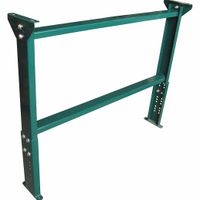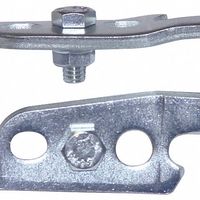Call +(254) 703 030 000 / 751 483 999 / 721 704 777
- Home
- Material Handling
- Transporting
- Conveyors Components
- Conveyor Support Stands Connecting Hardware
.....Read More
Frequently Asked Questions
What is the load capacity of conveyor support stands?
The load capacity of conveyor support stands varies widely depending on several factors, including the design, materials used, and the specific application for which they are intended. Generally, conveyor support stands are engineered to support the weight of the conveyor system itself, as well as the materials being transported.
Standard conveyor support stands are typically made from steel or aluminum, providing a robust structure capable of handling significant loads. The load capacity can range from a few hundred pounds to several thousand pounds. For example, light-duty stands might support loads up to 500 pounds, while heavy-duty stands can handle loads exceeding 5,000 pounds or more.
The load capacity is also influenced by the configuration of the support stands. Adjustable stands, which allow for height modifications, may have different load capacities at different heights. Additionally, the spacing between support stands plays a crucial role; closer spacing generally increases the overall load capacity of the conveyor system.
Manufacturers often provide detailed specifications for their support stands, including maximum load ratings, which should be adhered to in order to ensure safety and efficiency. It is essential to consider the dynamic loads, such as the impact of starting and stopping the conveyor, which can affect the overall load capacity.
In applications requiring custom solutions, engineers may design support stands with specific load capacities tailored to the unique requirements of the operation. This might involve using reinforced materials or specialized designs to accommodate higher loads or specific environmental conditions.
Ultimately, selecting the appropriate conveyor support stands involves understanding the specific needs of the conveyor system, including the weight of the materials being transported, the conveyor's dimensions, and the operational environment.
How do you adjust the height of conveyor support stands?
1. **Identify the Type of Support Stand**: Determine if the conveyor support stand is adjustable. Common types include telescopic, screw-type, or bolt-adjustable stands.
2. **Safety Precautions**: Ensure the conveyor is turned off and locked out to prevent accidental operation. Wear appropriate personal protective equipment (PPE).
3. **Loosen Fasteners**: For telescopic stands, locate the locking mechanism, which may be a bolt, pin, or clamp. Loosen or remove these fasteners to allow movement.
4. **Adjust Height**:
- **Telescopic Stands**: Slide the inner tube up or down to the desired height.
- **Screw-Type Stands**: Rotate the screw or threaded rod to raise or lower the stand.
- **Bolt-Adjustable Stands**: Remove bolts, reposition the stand to the desired height, and reinsert bolts.
5. **Level the Conveyor**: Use a spirit level to ensure the conveyor is even. Adjust each support stand as necessary to maintain a level surface across the entire conveyor.
6. **Secure Fasteners**: Once the desired height is achieved, tighten all fasteners securely to prevent movement during operation.
7. **Check Stability**: Ensure the conveyor is stable and does not wobble. Adjust as necessary to achieve stability.
8. **Test Operation**: Turn on the conveyor and observe its operation to ensure it functions correctly at the new height.
9. **Final Inspection**: Conduct a final inspection to ensure all adjustments are secure and the conveyor operates smoothly.
10. **Documentation**: Record the changes made for future reference and maintenance schedules.
How many conveyor support stands are needed for a specific conveyor setup?
To determine the number of conveyor support stands needed for a specific conveyor setup, consider the following factors:
1. **Conveyor Length**: Measure the total length of the conveyor. Support stands are typically placed at regular intervals, often every 5 to 10 feet, depending on the conveyor type and load.
2. **Conveyor Type**: Different types of conveyors (e.g., belt, roller, chain) may have varying support requirements. Check the manufacturer's guidelines for specific recommendations.
3. **Load Capacity**: Heavier loads may require more frequent support to prevent sagging or structural failure. Consider the maximum load the conveyor will carry.
4. **Material and Environment**: The material of the conveyor and the environment (e.g., indoor, outdoor, temperature variations) can affect the number of supports needed. For instance, outdoor conveyors may need more supports due to wind or other environmental factors.
5. **Conveyor Width**: Wider conveyors may require additional supports to maintain stability and prevent bending.
6. **Incline or Decline**: If the conveyor is inclined or declined, additional supports may be necessary to maintain the angle and prevent slippage.
7. **Manufacturer's Specifications**: Always refer to the manufacturer's specifications and guidelines for support placement, as they are tailored to the specific design and material of the conveyor.
8. **Safety and Regulations**: Ensure compliance with safety standards and regulations, which may dictate minimum support requirements.
Calculate the number of supports by dividing the conveyor length by the recommended interval, adjusting for any additional supports needed due to the factors above. Always round up to ensure adequate support.
What materials are conveyor support stands made from?
Conveyor support stands are typically made from a variety of materials, each chosen for its specific properties to suit different industrial applications. Common materials include:
1. **Steel**: Often used for its strength and durability, steel is a popular choice for conveyor support stands. It can withstand heavy loads and harsh environments, making it ideal for industries like mining and manufacturing. Steel stands are usually coated or galvanized to prevent rust and corrosion.
2. **Stainless Steel**: Known for its corrosion resistance, stainless steel is used in environments where hygiene is crucial, such as food processing and pharmaceuticals. It is also resistant to chemicals and can handle high temperatures, making it suitable for various industrial applications.
3. **Aluminum**: Lightweight and resistant to corrosion, aluminum is used for conveyor stands in industries where mobility and ease of installation are important. Its lower weight makes it easier to handle and transport, though it may not support as much weight as steel.
4. **Plastic**: High-density polyethylene (HDPE) and other robust plastics are used for conveyor stands in environments where chemical resistance is necessary. Plastic stands are lightweight, corrosion-resistant, and suitable for wet or corrosive environments, but they may not support heavy loads.
5. **Composite Materials**: These are used for specialized applications where a combination of properties is required. Composites can offer strength, corrosion resistance, and lightweight characteristics, making them suitable for specific industrial needs.
Each material offers distinct advantages and is selected based on factors such as load capacity, environmental conditions, cost, and specific industry requirements.
Can conveyor support stands be used with any type of conveyor system?
Conveyor support stands can generally be used with a wide variety of conveyor systems, but their compatibility depends on several factors. The primary consideration is the design and specifications of both the conveyor system and the support stands.
1. **Compatibility**: Support stands must be compatible with the conveyor's size, weight, and design. They should be able to support the conveyor's load capacity and align with its structural requirements.
2. **Adjustability**: Many support stands are adjustable, allowing them to accommodate different conveyor heights and angles. This feature enhances their versatility across various conveyor types.
3. **Material and Environment**: The material of the support stands should be suitable for the environment in which the conveyor operates. For example, stainless steel stands are ideal for food processing environments due to their corrosion resistance, while powder-coated steel might be sufficient for general industrial use.
4. **Conveyor Type**: Different conveyor systems, such as belt, roller, or chain conveyors, may have specific requirements for support stands. For instance, roller conveyors might need stands that can handle dynamic loads, while belt conveyors might require stands that provide stable, continuous support.
5. **Load and Speed**: The load capacity and speed of the conveyor can influence the type of support stands needed. High-speed or heavy-load conveyors may require more robust stands to ensure stability and safety.
6. **Installation and Maintenance**: Ease of installation and maintenance is another factor. Support stands should allow for easy access to the conveyor for maintenance and adjustments.
In summary, while conveyor support stands can be used with many types of conveyor systems, it is crucial to ensure they are appropriately matched to the specific requirements of the conveyor in terms of design, load capacity, material, and environmental conditions.
How do you ensure the stability of conveyor support stands?
To ensure the stability of conveyor support stands, follow these key steps:
1. **Proper Design and Engineering**: Ensure that the support stands are designed to handle the load and environmental conditions. Use appropriate materials and structural designs that comply with industry standards.
2. **Load Distribution**: Distribute the load evenly across the conveyor system. Avoid overloading any single section, which can lead to instability.
3. **Foundation and Anchoring**: Install the support stands on a solid foundation. Use anchors or bolts to secure the stands to the floor, preventing movement or tipping.
4. **Leveling and Alignment**: Ensure that the support stands are level and properly aligned. Use leveling tools during installation to maintain even height and alignment across the conveyor system.
5. **Regular Maintenance and Inspection**: Conduct routine inspections to check for wear, corrosion, or damage. Tighten any loose bolts and replace any compromised components promptly.
6. **Vibration Control**: Implement measures to minimize vibrations, such as using dampers or isolators. Excessive vibration can lead to loosening of components and instability.
7. **Environmental Considerations**: Account for environmental factors such as temperature changes, moisture, and chemical exposure, which can affect material integrity and stability.
8. **Load Testing**: Perform load testing to ensure that the support stands can handle the maximum expected load without compromising stability.
9. **Compliance with Safety Standards**: Adhere to relevant safety and industry standards, such as OSHA or ISO, to ensure that the support stands meet all necessary safety requirements.
10. **Training and Procedures**: Train personnel on proper loading and unloading procedures to prevent accidental overloading or uneven distribution of weight.
By implementing these measures, you can ensure the stability and safety of conveyor support stands, minimizing the risk of accidents and operational disruptions.
Are there specific maintenance requirements for conveyor support stands?
Yes, conveyor support stands have specific maintenance requirements to ensure their optimal performance and longevity. Regular inspections are crucial to identify any signs of wear, corrosion, or damage. Check for loose bolts, nuts, and other fasteners, tightening them as necessary to maintain structural integrity. Ensure that the stands are properly aligned and level to prevent undue stress on the conveyor system.
Lubrication of moving parts, if applicable, should be performed according to the manufacturer's recommendations to reduce friction and wear. Inspect the support stand's material for any signs of rust or corrosion, especially if the conveyor operates in a humid or corrosive environment. Applying a protective coating or paint can help prevent corrosion.
Check for any deformation or bending in the support stands, which could indicate overloading or improper use. Ensure that the load capacity of the stands is not exceeded, as this can lead to structural failure. If the conveyor system is adjustable, verify that the height adjustment mechanisms are functioning correctly and are securely locked in place.
Regularly clean the support stands to remove dust, debris, and any material build-up that could affect their stability or function. In environments with strict hygiene requirements, such as food processing, ensure that cleaning procedures comply with industry standards.
Finally, maintain a record of all inspections, maintenance activities, and any repairs performed. This documentation helps in tracking the condition of the support stands and planning future maintenance activities. Following these maintenance practices can help prevent unexpected downtime and extend the lifespan of conveyor support stands.

